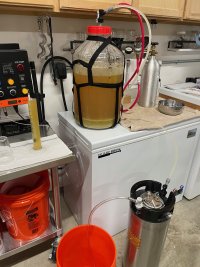CyberFox
Well-Known Member
- Joined
- Mar 29, 2022
- Messages
- 201
- Reaction score
- 82
I've done some research to figure out the best way to do a fully closed transfer from the fermenter to the keg for beer with a loose, 6+ oz dry hop. The best strategy I've found is to use gravity to transfer through the fermenter's spigot into the OUT post on the keg, then connect a line from the keg's IN post to the fermenter's airlock. An inline beer filter would also be used to catch any hops that try to get into the keg. Does anyone have experience doing this or have a better idea?
I need to get a new fermenter that is airtight with a spigot and I'm leaning towards something like a 7 gallon Fermonster, 7.9 gallon Speidel, or 7.5 gallon Anvil Bucket Fermenter. Does anyone have an opinion on which fermenter is best or know of an even better option that I didn't mention? Thanks in advance!
I need to get a new fermenter that is airtight with a spigot and I'm leaning towards something like a 7 gallon Fermonster, 7.9 gallon Speidel, or 7.5 gallon Anvil Bucket Fermenter. Does anyone have an opinion on which fermenter is best or know of an even better option that I didn't mention? Thanks in advance!
Last edited:





